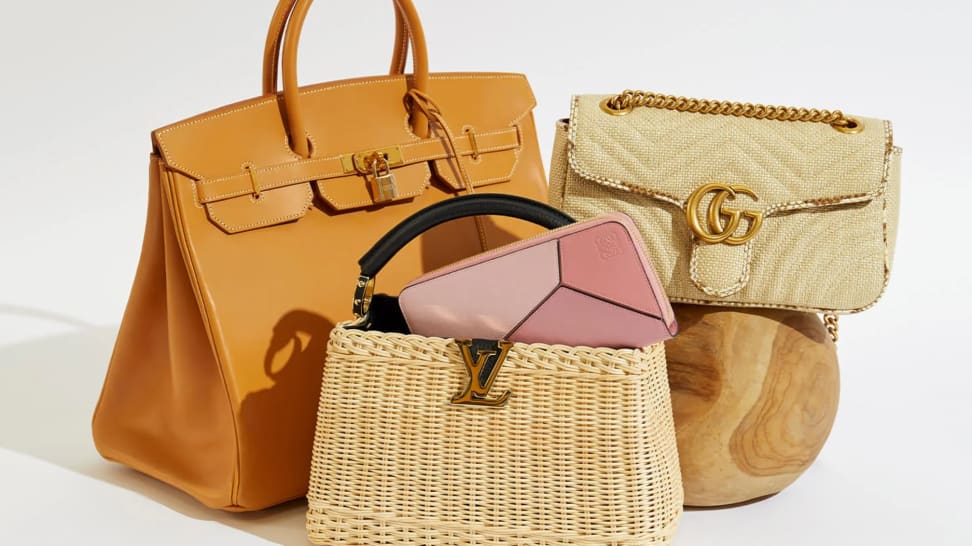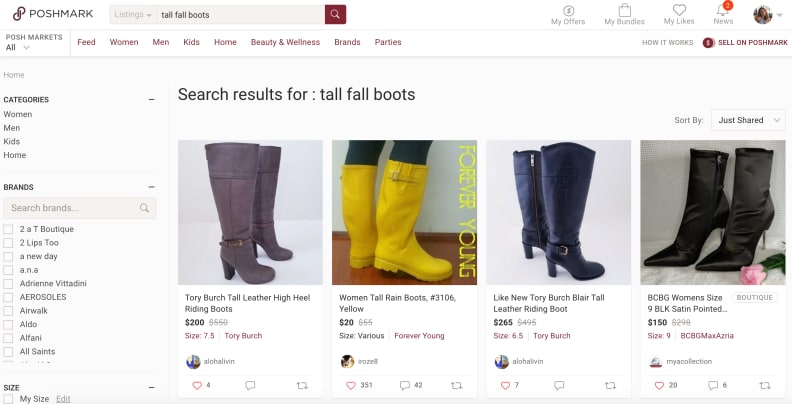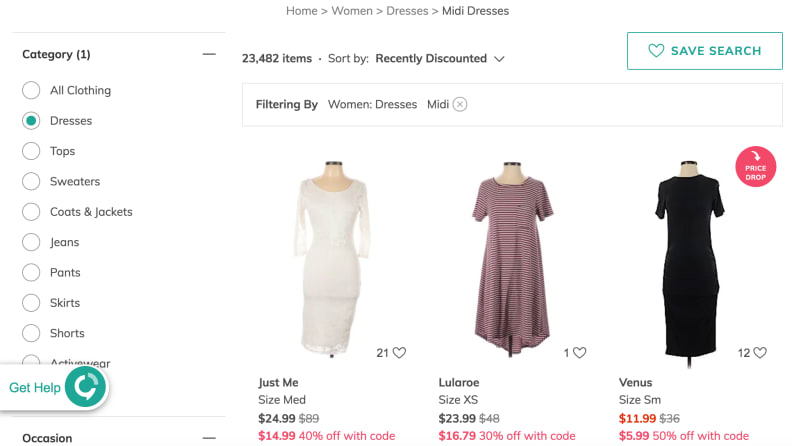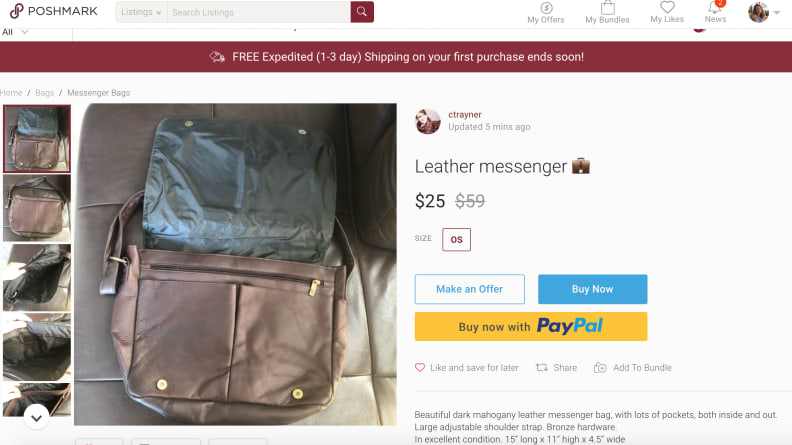8 secrets for shopping used clothing and resale items online
Shop smarter and safer with these tips.
 Credit:
The RealReal
Credit:
The RealReal
Products are chosen independently by our editors. Purchases made through our links may earn us a commission.
Facebook Marketplace, Poshmark, The RealReal, OfferUp. There’s no shortage of websites and apps offering secondhand finds. They’re great ways for sellers to unload unwanted merch and for buyers to get their hands on everything from everyday items to like-new luxury goods at a discounted price. It’s a win-win, right?
However, that online convenience can also come with a massive set of headaches. While sites like The RealReal and thredUP allow you to directly purchase from the company, other sites require you to interact directly with a seller, making for a very different (and sometimes frustrating) shopping experience. So how do you find the best deals, prevent yourself from being scammed, and maintain your safety if you meet up in person?
Below you’ll find eight tips to make shopping for secondhand clothing and items online less stressful, from picking the right online thrift shop to interacting with sellers to make sure you're getting exactly what you saw.
1. Determine the site that’s best for you
Because there are so many online options for purchasing secondhand items, your choice of where to shop truly depends on what you’re looking for. Poshmark, a relatively easy to use app, is known for trendy clothing and some designer pieces for a fraction of the cost sold directly by sellers. ThredUP, on the other hand, calls itself the largest online consignment and thrift store, has clothes, shoes, and accessories from more than 35,000 brands. It’s kind of like the online version of Buffalo Exchange or Plato’s Closet.
But if you’re looking for high-end consignment, check out The RealReal, which is filled exclusively with luxury items and sells designs from the likes of Chanel, McQueen, Balmain, and more that have been pre-authenticated by a team of experts. Whether you want to deal with sellers online or try to snag expensive pieces for less will be your main deterrent for what site you chose to browse through first.
2. Let the search field do the work for you

Get super specific in your searches to find exactly what you're looking for.
Like thrift shopping IRL, there’s a lot to sift through on these digital vintage markets. It’s far too easy to fall down a rabbit hole of searching for, well, everything and nothing at the exact same time. Before diving in, have a general idea of what you’re on the hunt for and use the search function, which all popular resale sites have. Start with the size, color, brands, and designer to immediately narrow your search. Then, get extremely specific with terms like “tall fall boots” or “oversized sweater.” A good listing will most likely have these keywords in the description. Plus, instead of scrolling through endless pages of items that may be of little interest or out of your budget, this widdles your options down to reasonable finds.
3. Save your favorites

ThreadUP allows you to favorite items and see how many favorites an item currently has.
Find something you like, but you’re not quite ready to buy yet? Many sites allow you the option to “like” or save your favorite picks. Bookmarking makes it easy to refer back to a listing when you’re ready to purchase, but it can also result in an even greater discount later on. “Liking” items on Poshmark can alert you when a seller is offering a discount on the product and thredUP has a “My Favorites” tab and the company emails you if the price drops, which is especially handy if you’re trying to score a deal on a designer item.
4. Beware of seller red flags
It always feels like a gamble when you’re purchasing an item directly from a seller, rather than a company. A great way to weed out some scammers is to pay close attention to their profile. First, do they even have a profile photo or is it just a random picture of a flower? For a site like Facebook Marketplace, click their profile to see the number of friends they have. If they only have a handful or most of their friends also don’t have a legitimate profile picture, that might be a red flag.
Also, take note of how they interact with other potential buyers in their comments. Do they actually respond to questions? Keep an eye out for sellers who only upload stock photos of products instead of taking photos of the actual item in their possession. This can mean they don’t actually have the item or they’re hiding its true quality.
5. Ask questions, tons of them
Some sellers are pros at taking great photos from every angle and including all the necessary measurements in the description, but other listings leave a lot to be desired. Don’t be afraid to reach out to the seller directly or leave a comment asking for additional information. Though a garment might list the size (small, medium, large, etc.), it’s always best to have actual measurements to ensure a proper fit.
Also, ask for more photos if you can. While The RealReal and thredUP take their own professional photos of items, other sites only have sellers directly upload images. That sometimes means the photo quality isn’t the best or there are very limited angles shown. In cases like this, ask to see additional angles, especially of the areas of garments that might reveal a lot of wear, such as the crotch of pants, soles of shoes, or armpits of a shirt. It can really make or break if the item was actually worn “only once or twice.”
6. Negotiate price when possible

Poshmark has an option to make an offer, which can be lower than what the seller asked for
Haggling for a lower price can often feel intimidating, but it’s absolutely acceptable and sometimes even expected when a transaction is directly between a buyer and seller. Both Poshmark and OfferUp (which joined forces with its competitor Letgo in early 2020) have a “make an offer” button so you can privately negotiate with a seller. You can immediately offer a lower price or wait until you’ve received additional details about an item. Either way, most sellers will entertain bargaining as long as you’re not lowballing them (for example; less than half their initial price).
7. Research the return policy
Before hitting that buy button, check (and double check) the return policy so you don’t wind up with an item you hate but can’t get your money back. The RealReal and thredUP accept returns on most items within 21 and 14 days, respectively. Poshmark and OfferUp items that are shipped have a buyer protection, but you have to act fast, usually within two to three days of receiving an item that’s damaged or not as described in the listing. If the item doesn’t fit or you simply don’t like it, you’re out of luck as refunds are usually denied. For in-person transactions like Facebook Marketplace and OfferUp, it’s always best to inspect every inch before exchanging money because all sales are final.
8. Maintain safety if meeting in person
Lastly—but most importantly—for any transaction that requires you to meet in person, safety is the top issue. As mentioned earlier, always avoid sellers with incomplete or sketchy profiles. Seller sites also can also make you feel safer and more comfortable for meet-ups with verification. For example, OfferUp has a TruYou badge displayed on profiles of buyers and sellers who upload a copy of their state-issued identification, cell phone number, and take a selfie from inside the app.
As far as meet-up locations, public spaces are always the best, including police parking lots, and try to have someone come with you, if you can. Otherwise, consider turning on the location sharing function on your phone. And due to COVID-19 pandemic, many platforms recommend buyers and sellers wear masks and to practice social distancing, so don’t be afraid to message the seller asking them to wear one before you meet-up.
